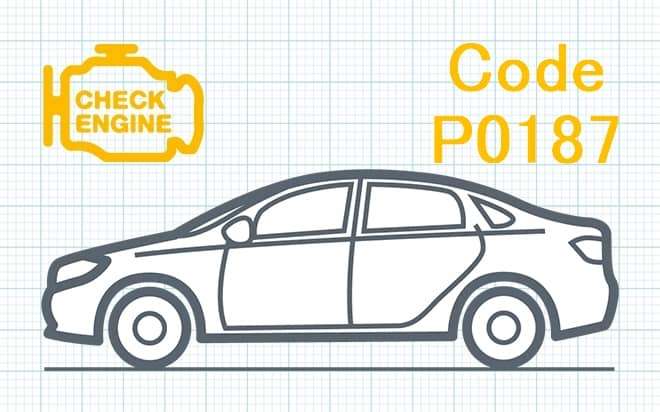
P0187 Fuel temperature sensor “B” circuit low
Content
P0187 – OBD-II Trouble Code Technical Description
Trouble code P0187 indicates that the fuel temperature sensor “B” circuit is low.
What does the fault code mean P0187?
When the vehicle's PCM detects that the fuel temperature sensor "B" circuit voltage is too low compared to the manufacturer's set value, it stores the P0187 trouble code in its memory. When this error occurs, the Check Engine light on the vehicle's dashboard lights up. However, it is worth noting that in some cars this indicator may not light up immediately, but only after the error has been detected multiple times.

Possible reasons
Some possible reasons for the P0187 trouble code:
- Fuel temperature sensor is faulty: The sensor itself can fail due to wear or damage, causing the fuel temperature to be incorrectly read.
- Wiring or Connectors: The wiring connecting the fuel temperature sensor to the PCM may be damaged, broken, or have poor connections. There may also be problems with the connectors.
- PCM faults: PCM malfunctions or malfunctions can also cause this code to appear.
- Fuel system problems: Problems with the fuel system itself, such as clogs or defects in the fuel lines, can also cause the P0187 code.
- Low fuel quality: Using low quality fuel or mixing fuel with impurities may affect the performance of the fuel temperature sensor.
It is important to conduct detailed diagnostics to accurately determine and eliminate the cause of the P0187 code.
What are the symptoms of trouble code P0187?
Some possible symptoms that may accompany the P0187 trouble code:
- Check Engine Indicator: The appearance of this code is usually accompanied by the Check Engine light turning on on the vehicle's dashboard.
- Incorrect fuel temperature readings: It is possible that the fuel temperature reading on the instrument panel will be incorrect or abnormal.
- Poor engine performance: Incorrect fuel temperature readings can cause the engine to operate incorrectly, which may result in rough idling, loss of power, or unusual vibrations.
- Startup problems: If there is a serious problem with the fuel temperature sensor or fuel system, it may be difficult to start the engine.
- Deterioration in fuel economy: Improper fuel system management caused by P0187 can result in increased fuel consumption.
If you notice one or more of these symptoms, it is recommended that you contact an automotive service immediately to diagnose and repair the problem.
How to diagnose a fault code P0187?
To diagnose DTC P0187, the following steps are recommended:
- Checking connections: Check the condition of all electrical connections associated with the fuel temperature sensor. Make sure all connectors are securely connected and not damaged or corroded.
- Visual inspection of the sensor: Inspect the fuel temperature sensor itself for damage or leaks. Make sure it is securely fastened and has no visible defects.
- Using the scanner: Connect the car scanner to the diagnostic connector and read the error codes. Check to see if there are other fuel system related codes besides P0187.
- Voltage measurement: Use a multimeter to measure the voltage at the fuel temperature sensor connector. Compare the measured voltage with the manufacturer's specifications.
- Resistance test: Check the resistance of the fuel temperature sensor. Compare the measured value with the technical data specified in your vehicle's repair manual.
- Checking the fuel system: Check the condition of the fuel system, including the fuel pump, filter, and fuel lines for leaks or blockages.
- PCM diagnostics: In some cases, the cause of the problem may be due to a problem with the engine control module (PCM) itself. Check its operation using specialized equipment.
Diagnostic errors
When diagnosing DTC P0187, the following errors may occur:
- Incorrect voltage measurement: Incorrect voltage measurement at the fuel temperature sensor or its connector may result in an incorrect diagnosis. Make sure the multimeter you are using is set to the correct measuring range.
- Faulty electrical connections: Incorrectly connected or damaged electrical connections may cause erroneous diagnostic results. Carefully check the condition of all wires and connectors.
- Problems with the sensor itself: If the fuel temperature sensor is faulty or out of calibration, this can also lead to an incorrect diagnosis. Make sure the sensor is functioning correctly.
- PCM problems: If the engine control module (PCM) has malfunctions or software errors, it may cause the data from the fuel temperature sensor to be incorrectly analyzed. Check the condition of the PCM and its communication with other vehicle systems.
- Source of error on another system: Some problems with the fuel system or ignition system can cause the P0187 code to appear. It is important to carefully diagnose all elements related to engine operation.
To avoid diagnostic errors, it is recommended to carefully follow the diagnostic procedure, check each element in turn and, if necessary, use additional tools and equipment.
How serious is the fault code? P0187?
Trouble code P0187, indicating low voltage in the fuel temperature sensor “B” circuit, is relatively serious. Low voltage may be a sign of a problem with the fuel temperature sensing system, which can lead to improper fuel delivery to the engine and various engine performance problems.
Although the engine may continue to operate with this fault, its performance, operating efficiency and fuel consumption may be affected. Moreover, such an error may be a warning of more serious problems in the fuel supply system, which can lead to serious engine damage or even an accident.
It is recommended to immediately diagnose and eliminate the cause of the P0187 code to prevent possible negative consequences for engine performance and driving safety.
What repair will help eliminate the code? P0187?
To resolve DTC P0187, the following steps are recommended:
- Checking the fuel temperature sensor: Check the fuel temperature sensor “B” for damage, corrosion, or an open circuit. Replace the sensor if necessary.
- Checking wiring and connections: Check the wiring and connectors connecting the fuel temperature sensor “B” to the engine control module (PCM). Make sure all connections are secure and there are no electrical interruptions. If necessary, repair or replace damaged wires and connectors.
- Checking and replacing the control module: If all the previous steps do not resolve the problem, the engine control module (PCM) may need to be inspected or replaced. This may require specialized equipment and experience, so it is best to leave the job to a qualified auto mechanic or service center.
- Clearing errors: After repairs have been made and the cause of P0187 has been resolved, you must clear the error code from the PCM memory using a diagnostic scan tool. This will ensure that the problem has been successfully resolved and does not occur again.
When carrying out any repair work, it is recommended that you follow the vehicle manufacturer's instructions and use the appropriate tools and parts. If you do not have experience in auto repair, it is better to turn to professionals.
P0187 – Brand-specific information
Trouble code P0187 can apply to different makes of vehicles. Below is a list of some brands and their meanings for this code:
- Ford – Fuel temperature “B” sensor, low input voltage
- Chevrolet – Fuel Temperature Sensor “B” Low Input Voltage
- Toyota – Fuel temperature sensor “B” range diagram is too low.
- Honda – Fuel temperature “B” sensor 1, low input voltage
- BMW – Fuel temperature sensor “B” range diagram is too low.
- Audi – Fuel temperature sensor “B” range diagram too high
- Mercedes-Benz – Fuel temperature sensor “B” voltage too low
- Volkswagen – Fuel temperature sensor “B” voltage too low
Consult your specific vehicle's owner's manual or service manual for more details on how to resolve this code for your make and model.

